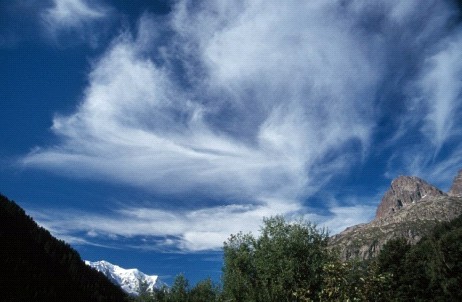Cirrus Clouds
 Pure ice clouds, so-called cirrus clouds, form at high altitudes and temperatures below -35°C, and typically contain ice crystal number densities in the range 0.1 to 10 cm-3.
Pure ice clouds, so-called cirrus clouds, form at high altitudes and temperatures below -35°C, and typically contain ice crystal number densities in the range 0.1 to 10 cm-3.
Whether cirrus clouds have a net cooling or heating effect on climate depends, among other factors, on the number concentration, size, and habit of ice crystals and therefore on the cirrus formation mechanisms. While thin and subvisual cirrus clouds are believed to warm the planet, the global effect of cirrus clouds is not fully understood.
Both homogeneous freezing of liquid aerosol particles and heterogeneous ice nucleation contribute to the formation of ice crystals in cirrus clouds. Mineral particles originating from desert dust storms, organic particles, and soot particles emitted by aircraft engines have been identified as ice nuclei in the free troposphere. Specific particle surface properties can markedly lower the ice supersaturation threshold for heterogeneous ice nucleation compared to the threshold required for homogeneous freezing, thereby changing not only the frequency of occurrence but also the microphysical and optical properties of cirrus clouds (indirect effect of INP on cirrus clouds).
